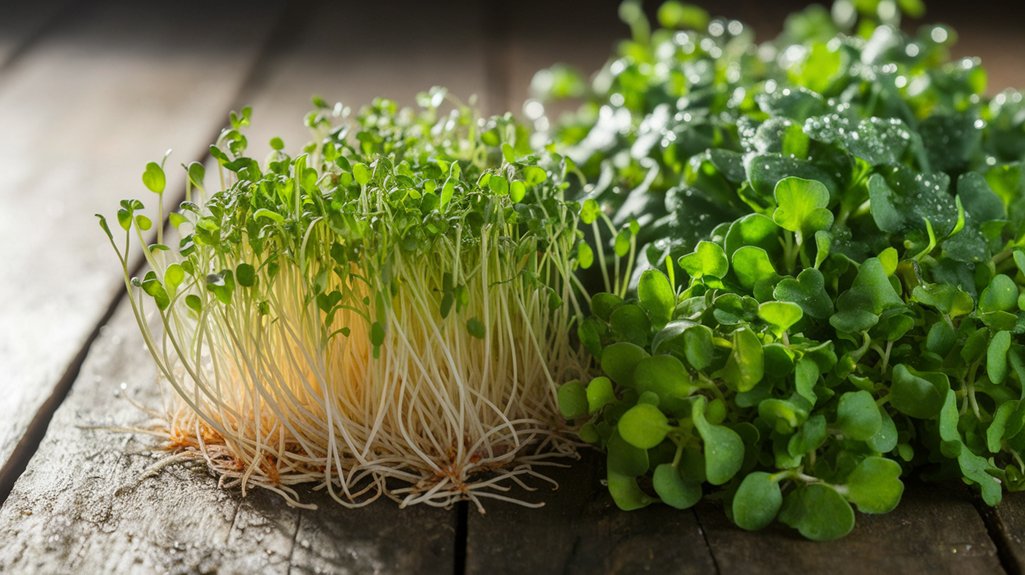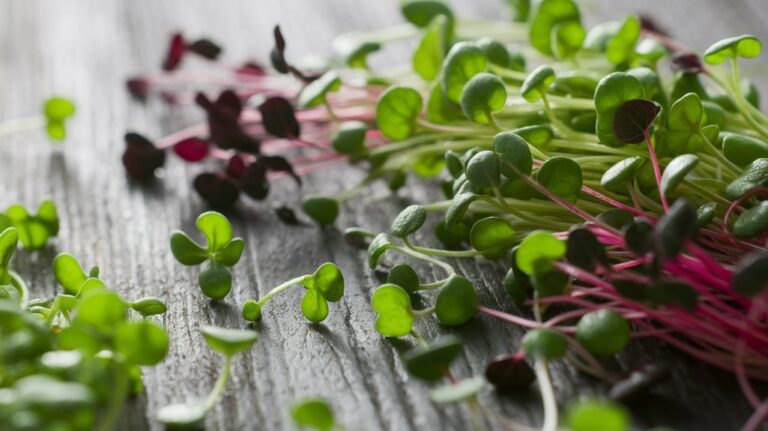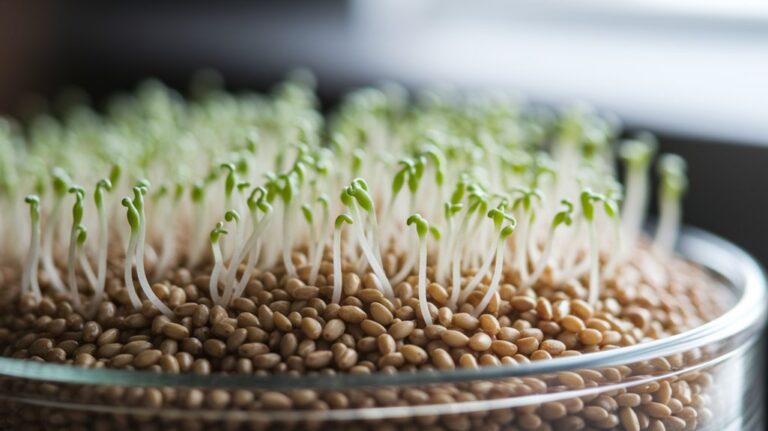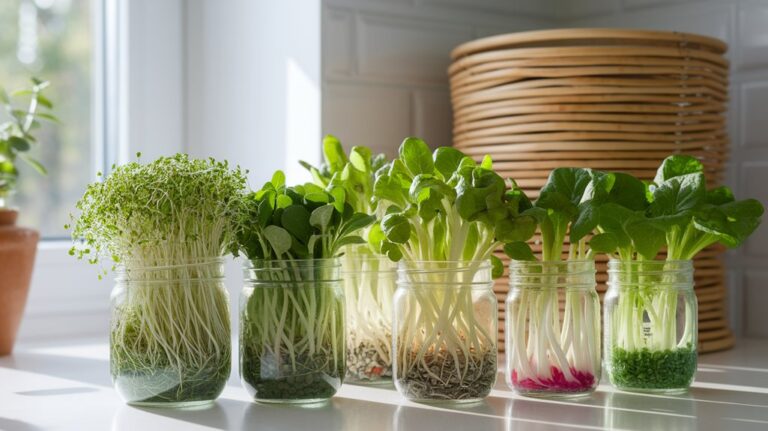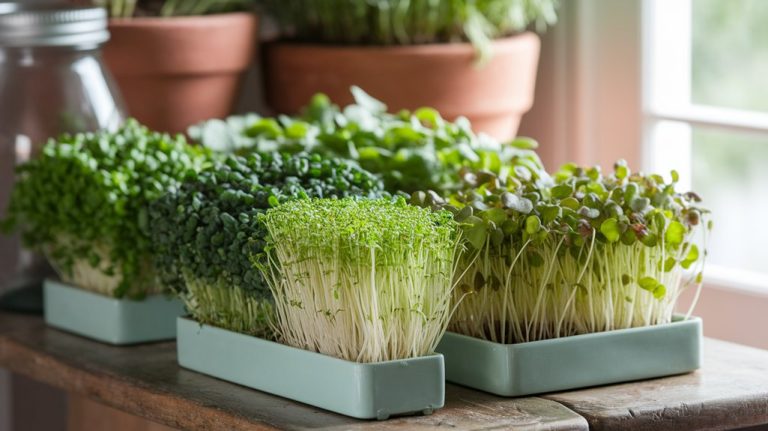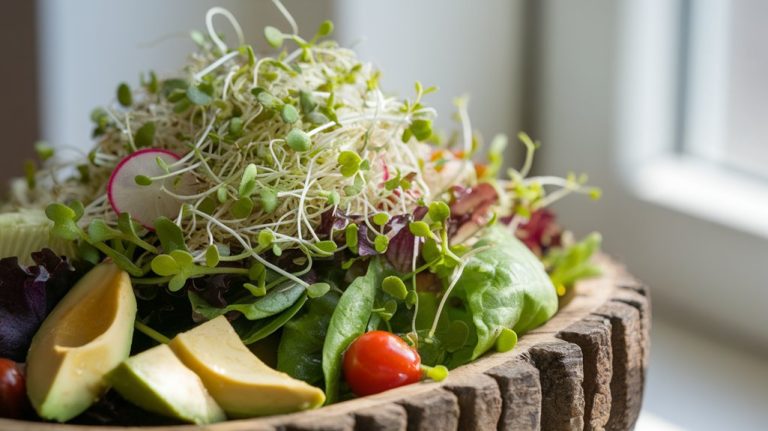Sprouts vs. Microgreens: Which Packs More Nutrients?
When it comes to nutrient density, microgreens generally outshine sprouts. Microgreens can contain up to 40 times more vitamins and minerals than their mature counterparts, offering concentrated nutrients like vitamins A, C, E, and K. In contrast, sprouts are also nutritious, rich in proteins and essential vitamins, particularly vitamin C and folate. Both are excellent additions to meals, and discovering their unique benefits can enhance your diet further. There’s more to explore about how to incorporate them effectively.
Key Takeaways
- Microgreens generally contain up to 40 times more nutrients than their mature counterparts, making them highly nutrient-dense options.
- Sprouts are rich in proteins, fiber, and essential vitamins, particularly vitamin C and B vitamins.
- Microgreens boast concentrated amounts of vitamins A, C, E, and K, along with important minerals like calcium and potassium.
- Both sprouts and microgreens provide significant health benefits, with sprouts having higher levels of vitamin C and folate.
- Microgreens typically have higher antioxidant levels compared to sprouts, enhancing their nutritional value.
Understanding Sprouts: Definition and Nutritional Benefits
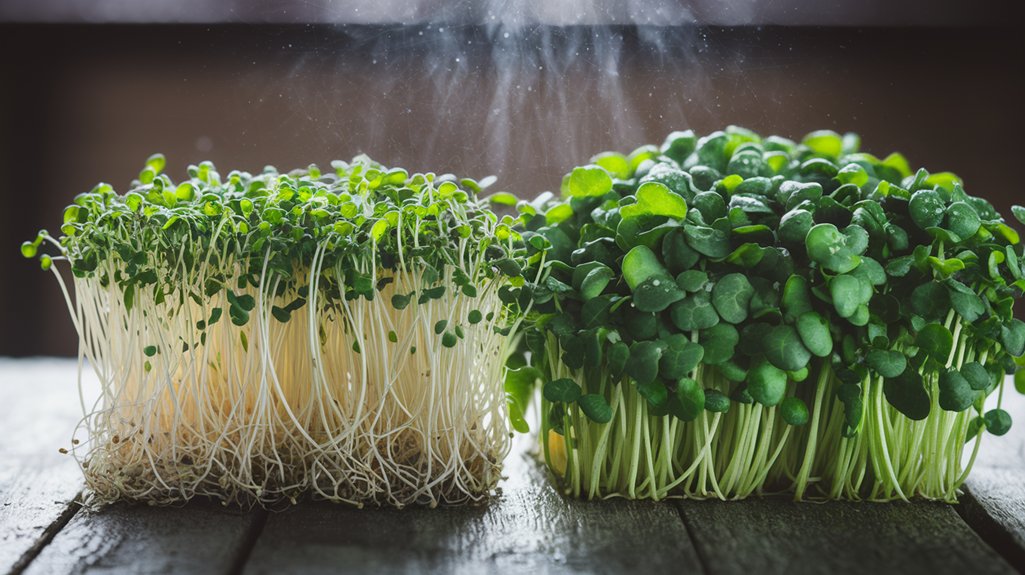
Sprouts are young plants that emerge from seeds after they’ve been soaked and allowed to germinate. They’re typically harvested within a week, making them an incredibly fresh addition to my diet.
Nutritionally, sprouts are packed with vitamins, minerals, and antioxidants, often containing higher nutrient levels than their mature counterparts. For instance, alfalfa sprouts provide significant amounts of vitamins A, C, and K, along with essential amino acids. Research indicates that germination increases the bioavailability of these nutrients, making them easier for my body to absorb.
Additionally, sprouts contain digestive enzymes that may aid in digestion. By incorporating sprouts into my meals, I not only enhance flavor but also boost my overall nutritional intake, making them a worthwhile addition to my diet.
Exploring Microgreens: Definition and Nutritional Benefits
Microgreens are the tiny, edible seedlings of various vegetables and herbs, harvested just after the first true leaves appear, typically within 7 to 21 days after germination. They’re not just visually appealing; their nutritional profile is impressive. Research shows that microgreens can contain higher concentrations of vitamins, minerals, and antioxidants compared to their mature counterparts.
Here’s a quick comparison of some popular microgreens and their benefits:
| Microgreen | Key Nutrient | Health Benefit |
|---|---|---|
| Arugula | Vitamin C | Boosts immune function |
| Radish | Vitamin K | Supports bone health |
| Sunflower | Vitamin E | Acts as an antioxidant |
| Beet | Folate | Aids in cell division |
Incorporating microgreens into your diet can be a simple way to enhance your nutritional intake.
Comparing Nutrient Density: Sprouts vs. Microgreens
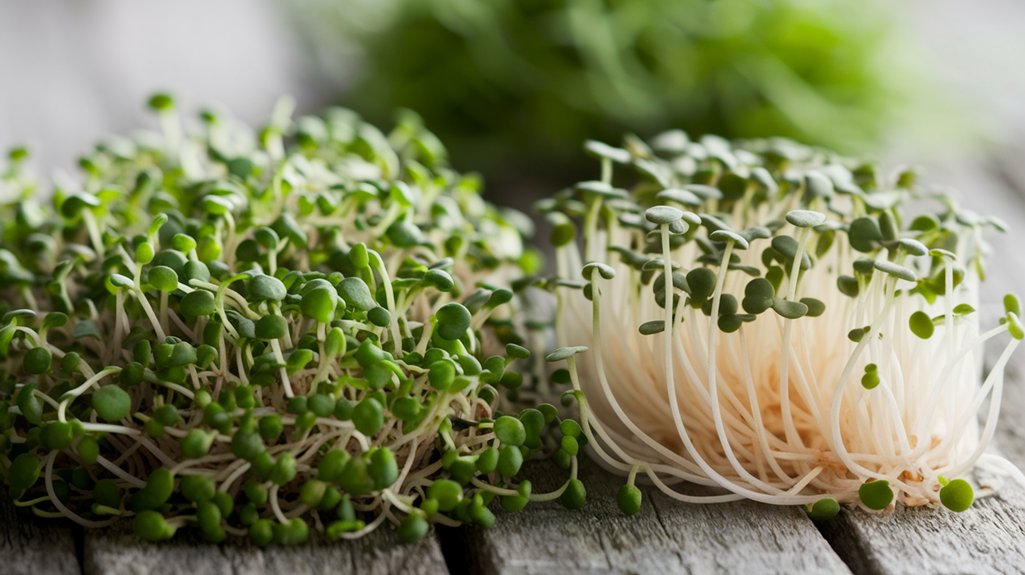
When I compare the nutrient profiles of sprouts and microgreens, I notice some intriguing differences that can impact our health.
Research shows that while both offer significant health benefits, the concentration of vitamins, minerals, and antioxidants can vary greatly between the two.
Understanding these differences can help us make informed choices about which to incorporate into our diets for optimal nutrition.
Nutrient Profiles Compared
While both sprouts and microgreens offer impressive health benefits, their nutrient profiles differ significantly, influencing their potential roles in our diets.
Sprouts, typically germinated seeds, are rich in proteins, fiber, and essential vitamins like vitamin C and B vitamins. They often contain higher levels of enzyme activity, which can aid digestion.
On the other hand, microgreens, harvested at an early growth stage, boast concentrated amounts of vitamins A, C, E, and K, as well as minerals like calcium and potassium.
Studies show that microgreens can have up to 40 times more nutrients than their mature counterparts.
Health Benefits Overview
Understanding the health benefits of sprouts and microgreens requires a closer look at their nutrient density. Both options offer unique advantages, but I find microgreens generally pack a bigger punch. Here’s a quick comparison of key nutrients:
| Nutrient | Sprouts (per 100g) | Microgreens (per 100g) |
|---|---|---|
| Vitamin C | 30 mg | 50 mg |
| Vitamin K | 50 mcg | 100 mcg |
| Antioxidants | Moderate | High |
| Fiber | 2 g | 1 g |
As you can see, microgreens often contain higher levels of vitamins and antioxidants, which are crucial for overall health. However, sprouts still provide valuable nutrients, making both a worthy addition to your diet.
Health Benefits of Incorporating Sprouts Into Your Diet
Incorporating sprouts into my diet has shown me just how nutrient-dense they’re compared to other options.
Their high levels of vitamins, minerals, and antioxidants support overall health, while also promoting digestive wellness.
Research indicates that these tiny powerhouses can enhance gut health, making them a smart addition to meals for anyone looking to improve digestion.
Nutrient Density Comparison
When I evaluate the nutrient density of sprouts compared to microgreens, it’s clear that sprouts pack a powerful punch in terms of health benefits. They are rich in vitamins, minerals, and antioxidants. For instance, sprouts often contain higher levels of vitamin C and folate, which are crucial for immune support and cell function. Here’s a quick comparison of key nutrients:
| Nutrient | Sprouts (per 100g) |
|---|---|
| Vitamin C | 70 mg |
| Folate | 150 mcg |
| Protein | 3 g |
| Fiber | 2 g |
| Antioxidants | 500 μmol TE |
Incorporating sprouts into my diet not only enhances flavor but also boosts my overall nutrient intake, making them a smart addition for health-conscious individuals.
Digestive Health Benefits
Sprouts not only contribute significantly to nutrient density but also play a vital role in digestive health. I’ve found that incorporating sprouts into my meals can enhance gut function due to their high fiber content.
Fiber acts as a prebiotic, feeding beneficial gut bacteria and promoting a balanced microbiome. Studies show that sprouts, particularly from legumes and whole grains, contain enzymes that aid in digestion, making nutrients more bioavailable.
Additionally, the presence of antioxidants in sprouts helps reduce inflammation in the gut, further supporting digestive health. By adding sprouts to salads or smoothies, I maximize my nutrient intake while ensuring my digestive system functions optimally.
It’s a simple yet effective way to promote overall wellness.
Health Benefits of Incorporating Microgreens Into Your Diet
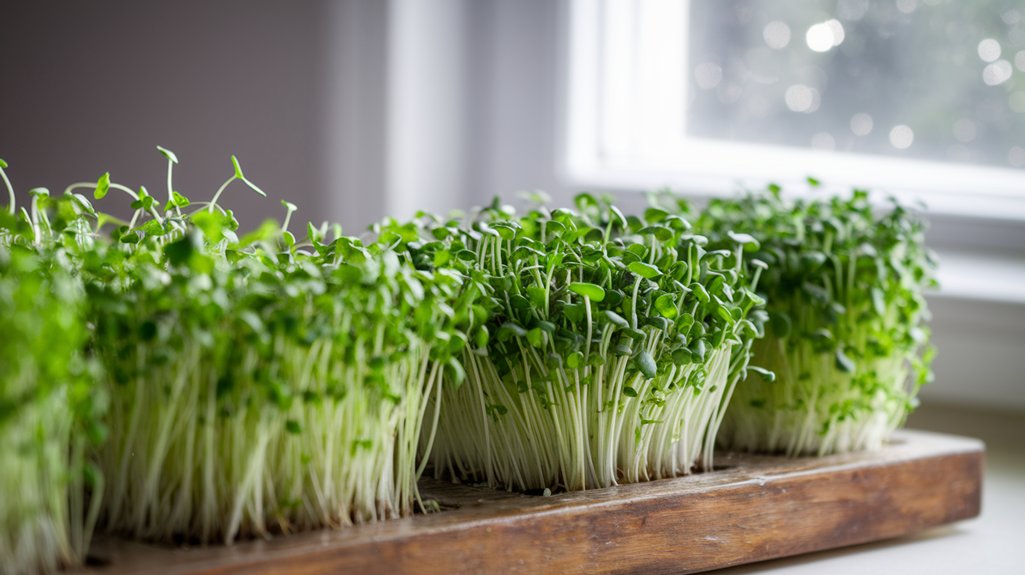
While many people overlook microgreens as mere garnishes, I’ve found that their impressive health benefits make them a worthy addition to any diet. Research shows that microgreens can contain up to 40 times more nutrients than their mature counterparts. Incorporating them into my meals has boosted my intake of essential vitamins and antioxidants, which support overall health.
Here’s a quick comparison of some popular microgreens:
| Microgreen | Nutrients |
|---|---|
| Arugula | Vitamin K, Vitamin C, Calcium |
| Broccoli | Sulforaphane, Vitamin A |
| Radish | Vitamin E, Folate, Potassium |
These tiny powerhouses not only enhance flavor but also provide significant health benefits, making it easier to nourish my body effectively.
How to Choose and Use Sprouts and Microgreens in Your Meals
Incorporating microgreens into my diet has led me to explore the equally nutritious world of sprouts. When choosing sprouts, I look for those that are fresh, crisp, and free from any signs of mold. Popular options like alfalfa, broccoli, and radish offer diverse flavors and health benefits.
For microgreens, I prefer varieties like arugula, basil, and beet greens, which pack a punch in terms of taste and nutrients.
I love adding both to salads, sandwiches, and smoothies to enhance flavor and nutrition. Sprouts work well as a crunchy topping on dishes, while microgreens can elevate the aesthetic appeal of my meals.
Ultimately, experimenting with different combinations helps me discover what I enjoy most, making my meals not only healthier but also more exciting.
Frequently Asked Questions
Can Sprouts and Microgreens Be Grown Indoors?
Absolutely, I’ve grown both sprouts and microgreens indoors with great success! They thrive in small spaces and don’t require much light.
For sprouts, I use a jar or a sprouting tray, while microgreens need shallow trays with soil. I’ve noticed that they both flourish with regular watering and some indirect sunlight.
It’s a rewarding process, and I love having fresh greens available right in my kitchen, no matter the season!
How Long Do Sprouts and Microgreens Last in the Fridge?
When it comes to how long sprouts and microgreens last in the fridge, I’ve found that sprouts typically stay fresh for about 5 to 7 days, while microgreens can last up to 10 days.
To maximize their longevity, I store them in a breathable container and keep them away from moisture.
Regularly checking for any signs of spoilage also helps ensure I’m enjoying them at their best and most nutritious.
Are There Any Allergens Associated With Sprouts or Microgreens?
When considering allergens, I’ve found that both sprouts and microgreens can trigger reactions in sensitive individuals.
Sprouts, especially legume sprouts like alfalfa, may contain proteins that lead to allergic responses.
Microgreens, while generally safer, can still pose risks, particularly for those allergic to specific seeds, such as mustard or radish.
It’s essential to know your allergies and consult a healthcare professional if you’re unsure about including these foods in your diet.
Can You Eat Sprouts and Microgreens Raw?
I often enjoy eating both sprouts and microgreens raw, and I find them delicious and nutritious.
Sprouts, like alfalfa and broccoli, can be eaten straight from the package, while microgreens, such as radish and basil, add vibrant flavors to dishes.
I always make sure to wash them thoroughly to eliminate any potential contaminants. Eating them raw retains their nutrients and provides a fresh crunch that enhances my meals.
What Are the Best Growing Conditions for Sprouts and Microgreens?
When growing sprouts and microgreens, I’ve found that light, temperature, and moisture are crucial.
Sprouts thrive in a dark, warm environment with consistent moisture, typically requiring 70°F to 75°F. In contrast, microgreens need indirect sunlight or grow lights to develop vibrant colors and flavors.
I keep the soil moist but not soggy, ensuring good drainage. By maintaining these conditions, I’ve always enjoyed healthy and nutritious greens from my garden.
Conclusion
In conclusion, both sprouts and microgreens offer impressive nutritional benefits, but they cater to different dietary needs. While sprouts are rich in proteins and essential enzymes, microgreens pack a punch with higher concentrations of vitamins and minerals. Incorporating both into your meals can enhance your overall nutrient intake. Ultimately, the choice depends on your personal health goals and taste preferences. So, experiment with both to find what works best for you and your dietary lifestyle.

